Fight against diseases and pests of cherries

Cherries in the garden are not only very beautiful, but also practical. But a good harvest of tasty berries is threatened by diseases that can significantly undermine the health of the tree. And if a cherry is planted next to a cherry, this is an even greater threat to both trees. In order not to miss the disease, notice the problem in time and solve it, it makes sense for a gardener to learn something about the most common and dangerous ailments of cherries.

Treatment of major diseases
Cherry cannot be considered a capricious tree, but her immunity is still not the most exemplary. Any disease can change the life cycle of a culture that will cease to grow and develop, bloom and bear fruit.... Timely processing saves from many defeats. Unfavorable climatic conditions, pests, injuries to branches and bark, diseases of neighboring plants - all this really threatens the cherry. And you need to know the enemy by sight.
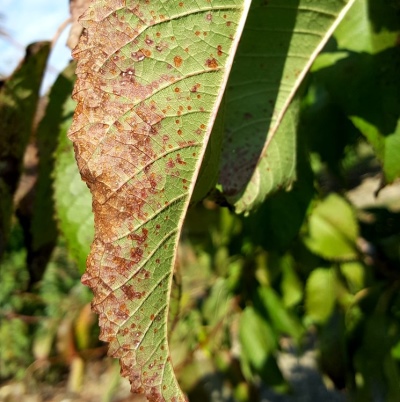
Fungal
These are the ailments that are caused by a fungus, more precisely, various fungi. The first that immediately comes to mind is a disease called coccomycosis. Red dots appear on the leaves of the cherry, rather small. Moreover, they appear on both sides of the sheet. Then the leaf becomes covered with a pink bloom, and then completely falls off. The fungus that causes this hibernates in fallen leaves. During the flowering period, the disease most often manifests itself. The method of treatment is simple and radical - treat the plant with iron sulfate, and the treatment should be before flowering. And then a month later, after flowering, the treatment should be repeated. And in the fall, a month after the harvest, the final processing is carried out. For 1 bucket of water 350 g of vitriol.
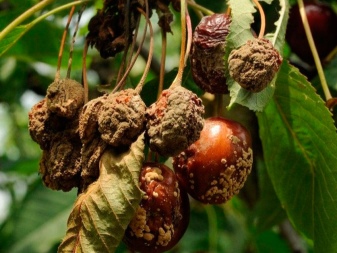
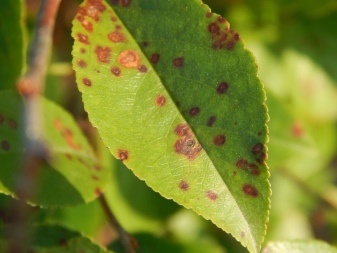
Here are some other fungal diseases that attack cherries.
-
Moniliosis. Elongated and brown shoots speak of just such a misfortune. Gray-green growths may begin to form on the bark. Berries also come with gray growths - they, the fruits, will eventually die. But it is also dangerous that, if you ignore the problem, not only the berries rot, but the shoots also die off. Bordeaux liquid, copper or iron vitriol, "Topsin" or "Skor" will help.
First, the tree is processed before the flowering period, then after its end.
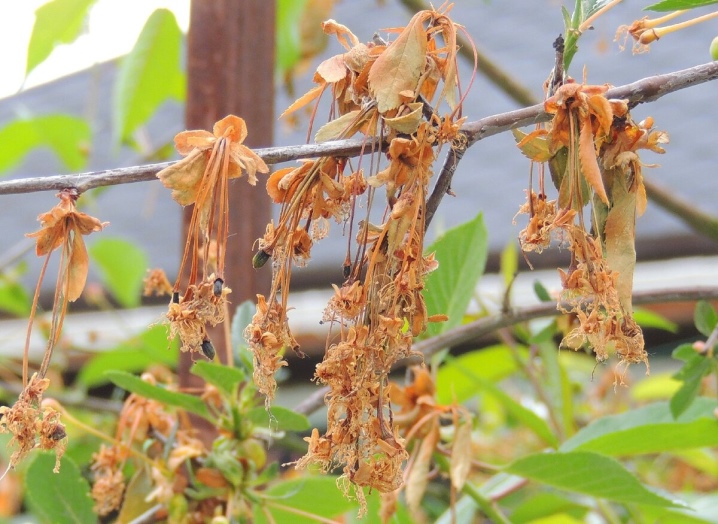
- Anthracnose... If yellowish spots appear on the fruit surface, after a few days they become dark growths (with a pinkish tinge), then this is anthracnose. The berries will dry out and fall off if the gardener does not get involved in the struggle. Diseases are favored by windy and humid weather, so it is easier for spores of the fungus to travel long distances. By the way, spores quietly winter on fallen berries. If the cherry is infected, before flowering it is treated with "Polyram" (dissolve 20 g in a bucket of water).
The second treatment will be after flowering, and the third - a couple of weeks after harvest.
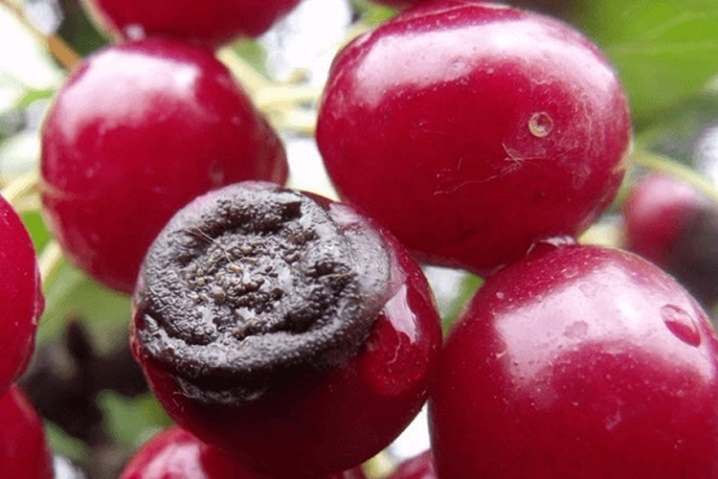
- Rust... Another popular, alas, fungal disease, it manifests itself on the leaves, and not immediately. On the upper part of the leaf, brown tubercles appear, very similar in color to just rust. Spores of the fungus hibernate on the leaves, and if the tree is not treated, exactly all the foliage will fall off. You can fight the disease with copper chloride, and Bordeaux liquid is also suitable.
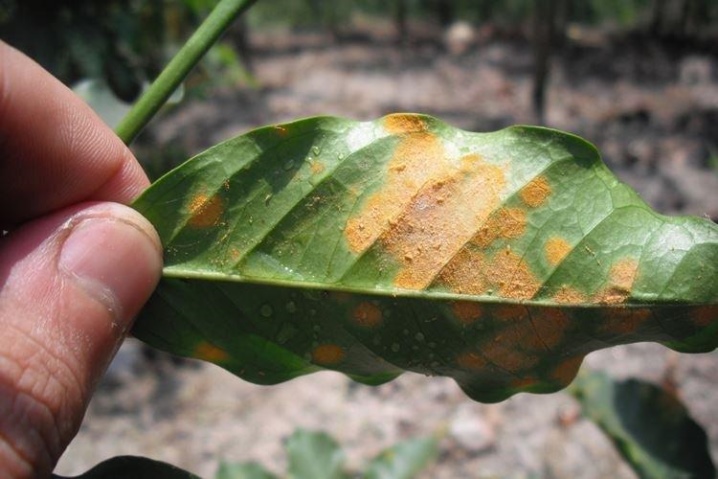
- Scab... On berries and leaves, brown-green spots velvety in texture appear. The spores of the pathogen fungus very quickly scatter with the wind, the whole garden can get sick with scab. Cracks appear on the affected fruits, and more than half of the crop per season can be lost like this.Fungicides (for example, "Hom" and "Fitosporin M") will help to resist the disease. In addition to the tree, the soil around it is also cultivated.
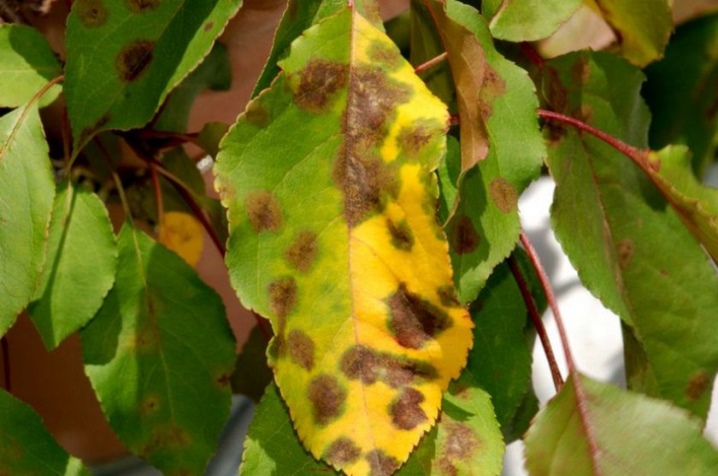
- Clasterosporium disease... With this ailment, the leaves turn yellow, specks appear on them that can reach 2 cm.Over time, the spots will be surrounded by a red border, after a week holes will appear in place of the spots. The leaves will crumble soon. Yes, and for the fruit, this disease is dangerous, purple depressed spots on the berries indicate this.
The tree must be sprayed with a solution of Bordeaux liquid, and this must be done before bud break or during bud formation.
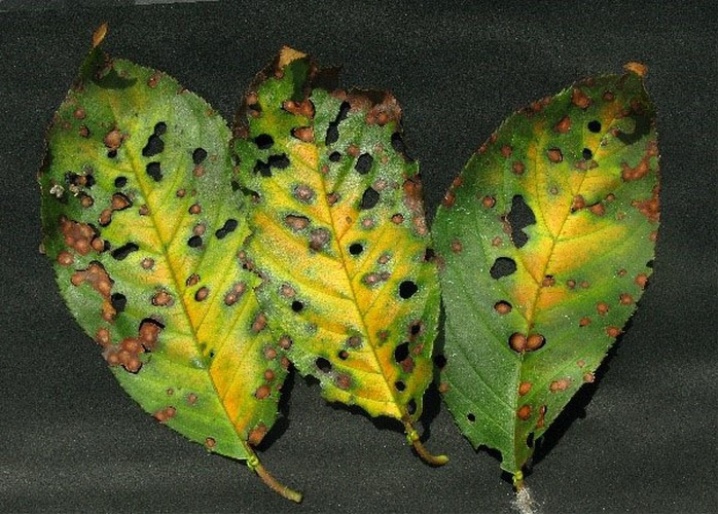
If only these diseases threatened cherry - in addition to fungi, other pathogens also attack it.
Non-fungal
Hommosis is a gum disease, a disease that is quite common for stone fruit trees. It affects the bark, branches, fruits. When the branches are damaged, the cambium is injured, they can no longer grow in thickness. And together with the gum, the fungus of moniliosis perfectly spreads. To avoid gommosis, it is necessary not to overmoisten the soil, not to overdose on fertilizers, cut off branches affected by frost, and protect them from burns. And to treat already formed wounds, if they fit the description of the ailment, it is necessary to use garden varnish, a one-percent solution of copper sulfate. If the wound is very large, hitting the trunk, for example, you can mix clay and cow dung in equal proportions.
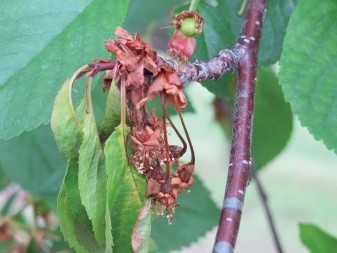

Another cherry disease, this time of a bacterial nature, is root cancer.... It is expressed by tumor growths appearing on the neck, main and lateral roots. At first, the growths will be small, soft, smooth. But the disease will progress, and they will grow, become hard and bumpy. In the fall, the galls (growths) will collapse. The disease should be treated with a three percent solution of ferrous sulfate before and after the growing season.
It is also worth mentioning that, in addition to bacterial and viral diseases, mosses and lichens attack cherries. Mossiness definitely weakens the tree, making it more vulnerable.
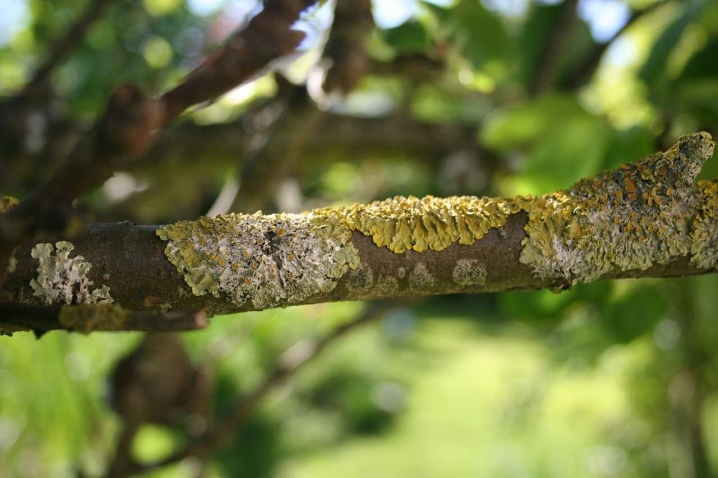
Branches can die off, productivity is significantly reduced. The tree must be cleaned if such an attack manifests itself. And do this until the kidneys swell and after leaf fall. First, the fallen leaves are removed, then a 5% solution of copper sulfate is taken, 50 g of which is diluted in 1 liter of hot water, and then diluted in 10 liters of warm liquid. The near-trunk circle is dug up, already 3% copper sulfate is spilled with a solution. In about a week, the growths will disappear. And individual scales can simply be scraped off with a brush.
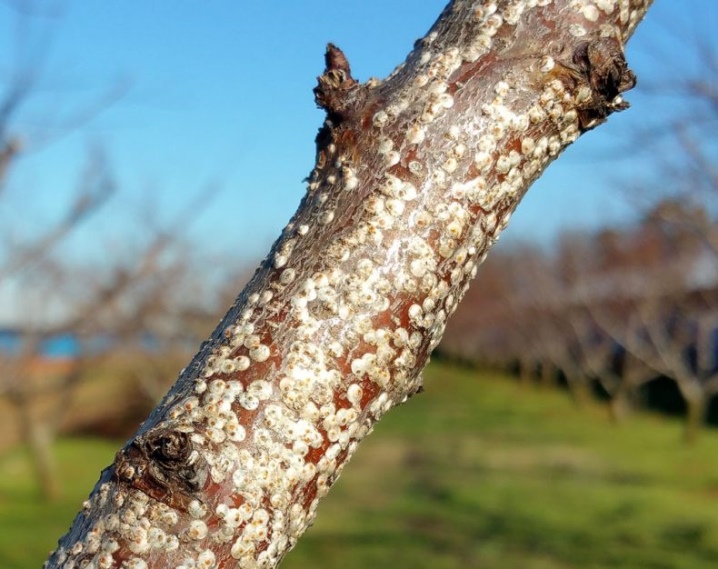
How to deal with pests?
Pests are also not averse to feasting on tree juices, and often fruits. And they shouldn't be allowed to do it.
Cherry slimy sawfly
Already in the middle of summer, this pest begins to be dangerous. He tries to strip the leaf completely, which is why it will probably dry out quickly. The sawfly, however, is not so tenacious, and if used against him, for example, "Actellic", he will quickly leave the garden. But if the attack is massive, it may need to be processed twice.
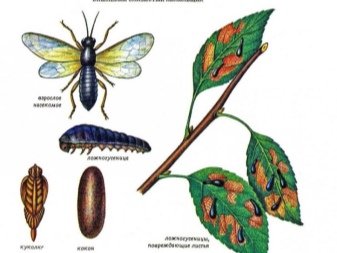
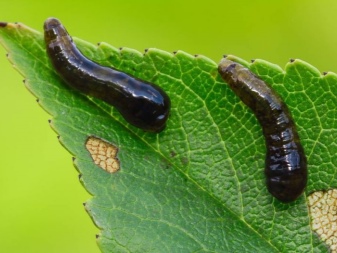
Aphid
The cherry aphid is easy to spot in early spring, it will be on the back of the leaf plate, and it also attacks young shoots... Aphids can be black or green in color. She sucks the juice out of the leaves, which makes them fall off. Very often, aphids infect cherries together with ants, and this is fraught with huge losses for the garden.
But to fight it is actually not so difficult: you need to prepare a solution of tobacco and laundry soap, the crown is sprayed with it. This is a good pest stopper, although not a remedy that will help completely eradicate aphids. Therefore, you will additionally have to treat the tree with a suitable insecticide (choose the one that says "from aphids").
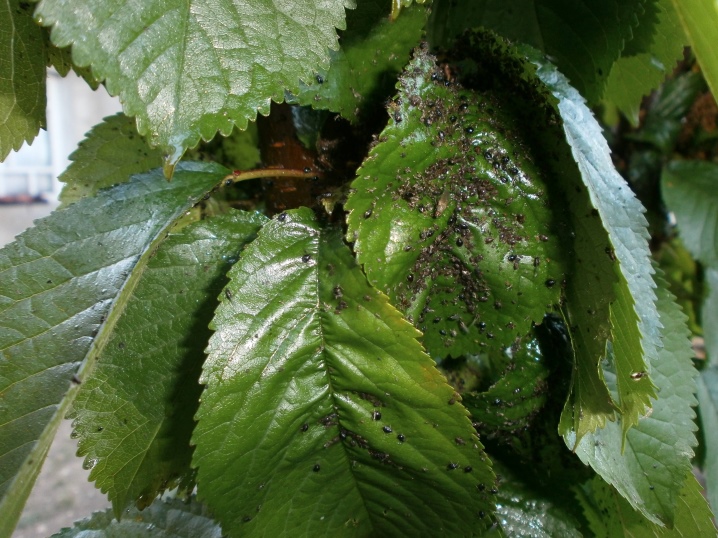
Weevil
This bronze-green pest (bright color) is the first to try to collect all the "cream" from the awakening cherry. First, he will drink the juice from the cherry buds, then he will feed on her berries. Weevils lay eggs inside the fruit pulp.The larvae will feed on berry juice, then fly out of the fruit and overwinter safely in the leaves until spring. One weevil can reduce the yield of a cherry tree by 80%.
In this case, it is necessary to fight with the larvae. In the fall, it is necessary to carefully dig up the periosteal circle. In the spring, when you see brown buds on a tree, you need to quickly remove them.

But if there is already an attack, and it is large, it will be necessary to attract insecticides - "Rovikurt" and "Aktellik". Once the buds have begun to form, they can be processed.
Hawthorn
In the form of a butterfly, it will not harm the cherry, but the caterpillar hawthorn feeds on kidney and leaf sap. The caterpillar is dangerous in that it can lay up to 500 eggs. You can, of course, manually collect this pest, you can attract tits to the site. But the result can be backed up by Metaphos and Karbofos. But the destruction of the population may still take a couple of years.
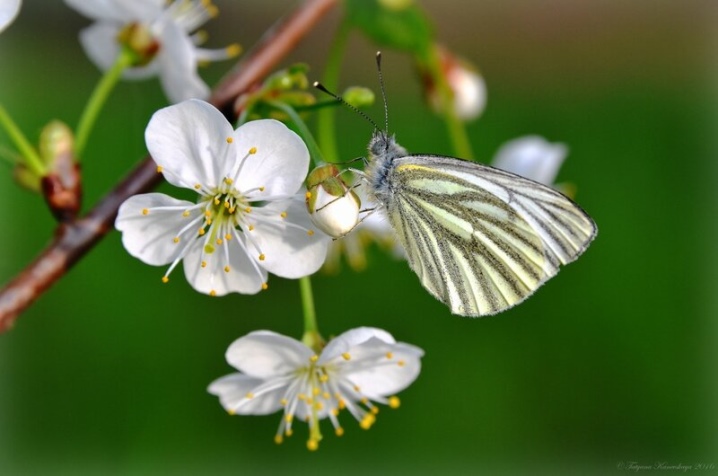
Moth
The cherry moth in its larval form hibernates under the bark. In the spring, the larvae become caterpillars, sucking juices from the buds, and then from the leaves. To destroy the pupae of the caterpillars, it is necessary to dig up the near-stem circle. And "Zolon" and "Iskra" can be used to treat a tree in spring.
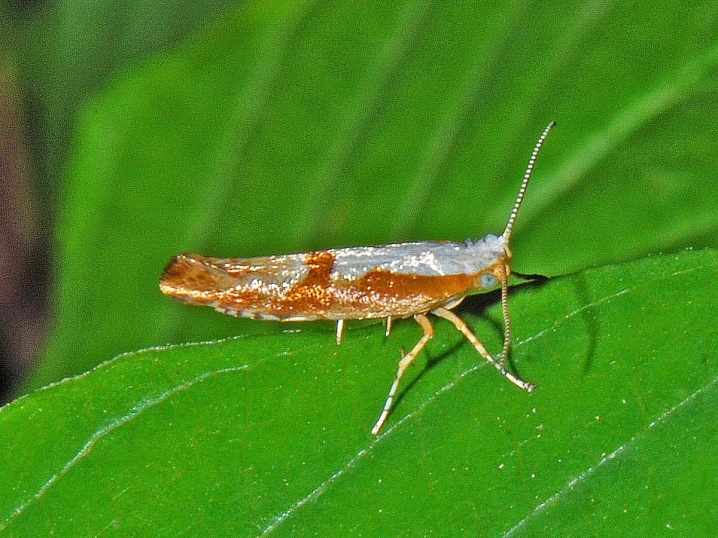
Prevention measures
Without preventive measures, nowhere. For example, you can protect yourself from fungal diseases if you cut off and burn those shoots and branches on which signs of the disease have already been found.
There are other gardeners' recommendations.
-
At the end of autumn, fallen leaves and fruits are collected and burned. It is in them that pests can hibernate. And it is better to burn all this also outside the garden, if there is such an opportunity.
-
In the spring, you can spray the tree with a 1% solution of copper sulfate.
-
The bark of the tree should be inspected regularly... If mechanical damage is found on it, the wound needs protection - garden var, or even just paint.
-
The trunk of a tree can be whitewashed in spring... Not everyone likes this practice, but in fact it is very useful.
-
It is better to remove weeds under planting.... Such processing is not necessarily necessary, but experienced gardeners assure that this is a good help for the health of the tree.
-
It is imperative to dig up the soil under the cherries. - this is one of the main preventive points.
-
Application of insecticides and fungicides - normal practice, even if the disease cannot be clearly diagnosed. If there are no worms in the fruits and on the leaves, if there is no cobweb, for example, but there are black dots or the leaves are curled, then the tree is sick. And the use of special equipment is better than crop loss. Alternative folk remedies are also used.
-
Treat, spray - that's understandable... But so that the tree is not attacked by some wormy brethren, it can be helped by timely feeding. In spring and summer, in autumn. It can be double superphosphate, potassium sulfate, humus.
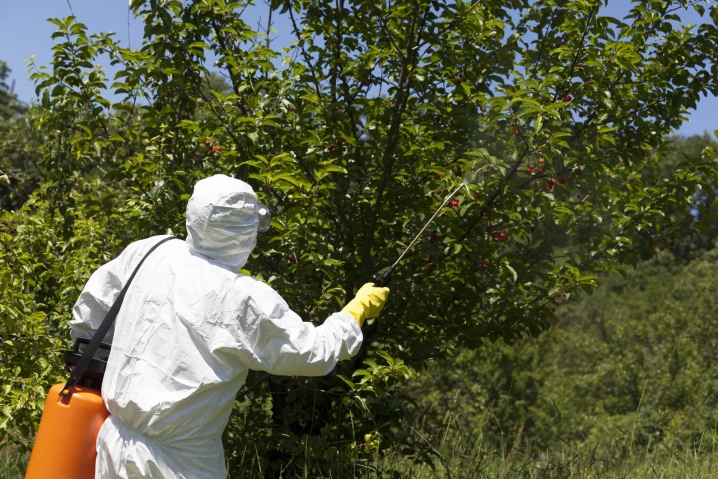
And, of course, you shouldn't plant cherries next to cherries. If, for example, the leaves of one tree turn black, then the neighboring cherry (whether bush or tree-like) will soon get sick.
Resistant varieties
It is very interesting to choose cherry varieties, to look for those that will be good in different directions. Indeed, among almost a hundred varieties, there are those that have really good characteristics (when, with resistance to diseases, the variety does not lose its beneficial taste and size).

These are the varieties gardeners consider the most successful and resistant to diseases and pests.
- "Dubovochka". The trees will not be particularly tall, but the variety promises early fruits and 9 kg of berries per tree. It is also a very winter-hardy variety. But, most importantly, it is considered one of the most invulnerable to diseases and pests.
- "Igritskaya"... A tree with large fruits, not tall in itself, perfectly tolerates the harsh winters of the middle zone (and the Moscow region as well). The variety is especially resistant to fungal diseases. Pollinators required.
- Loznovskaya... The tree grows above 3 m. The fruits of the variety are excellent.They will be very large, the yield is high, the fruits will ripen in the third decade of June. Cherries do not need pollinators and, most importantly, they do not get sick at all. There may be isolated cases, but there is not a word about this on the forum of gardeners. You definitely need to take a closer look. The variety is recommended for cultivation in the Saratov and Astrakhan regions.
- "Melody"... The tree is not particularly tall, the fruits are medium in size, at the end of June you can already try the harvest. It tolerates winters well, is not afraid of diseases. The variety is self-fertile, sometimes pollinators are required, sometimes not.
- "Seedling Lyubskoy". Not the tallest cherry will grow, but tasters do not regret evaluations to indicate the taste of the variety. Frost-resistant tree, also not afraid of drought and heat. It grows well in the Urals, in the Orenburg, Chelyabinsk regions.


Let the choice be justified, and all varietal characteristics exactly match their descriptions.









The comment was sent successfully.